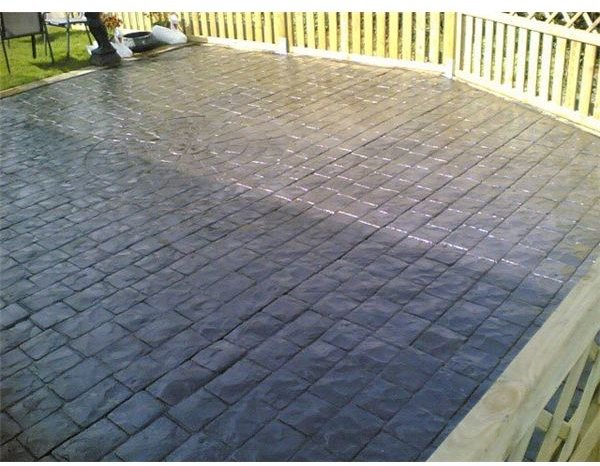Patterned Imprinted Concrete
Structure
The fundamental technique for this kind of paving is comparatively easy, containing a layer of concrete that is laid over an appropriate base. An edge or provisional shuttering may be utilized and detached after setting of the concrete. This may be possible normally four to eight days after the pouring has been completed. A dissimilar finish and color may be applied to the border of the surface to improve the appearance. A minimum thickness of 70 mm is advisable for the footpaths, and 90 mm for the driveways. Steel network may be used for reinforcement where heavy loads and extensive traffic is expected. Small size aggregate and fiber reinforcement is normally used that ensures that adequate quantity of matrix is available at the exterior for imprinting. Polyester fibers are also used to replace the expensive customary steel reinforcing net. The rate of surface micro fractures on the cured concrete is reduced that could ruin the finished appearance.
Preparation
After the preparation of the sub base, it is accurately leveled to make sure that the slab produced has uniform thickness. This is

performed to reduce the cracks, and obtain smooth slab curing. A sub base will only be necessary under the pavements that will carry vehicular loads. It may also be used below the driveways if extraordinary loads are expected. A sub-base is not normally essential beneath a pathway. Provisional formwork is created before the concrete delivery to hold the concrete at the free edges. Joints should be carefully controlled to prevent leakage of concrete mix. After the placement of the concrete, it is spread by using shovel and concrete rake. It is ensured to obtain a smooth and flat surface. Rollers are used to press any solid aggregate and achieve a smooth finish that does not contain any marks.
Applying Color
After the concrete filling and its proper floating, the excess water is removed. The particular color dyes and the surface hardening

agent are applied manually to ensure a proper distribution. This process is repeated initially in the vertical direction, and then in the horizontal direction. The color hardener is used in the appropriate quantity to ensure achievement of proper colors. Extensive dispersion of the color hardener may pollute other areas for which polythene sheets are used to prevent the spillage. To achieve the desired standards, a correct balance and dispersal of dye is carried out. This is a special talent on which perfection can only be obtained by experience. The purpose of the dye and hardener is to absorb the water from concrete, to produce a hard and enduring slab surface. The hardening agent has an instant effect and should be applied continuously to obtain the finest outcome. Pavement edges are usually smoothed with special tools.
Imprinting
Imprinting is performed by texture mats that are a kind of rigid plastic or a negative of the selected pattern. Flexible mats are used for the regions where hard mats cannot perform. Several mats are united to create a pattern spread over a large section. The normal pattern mats are required to precisely align themselves with the earlier imprinted concrete. The mats softly tap the workable concrete to imprint the selected pattern. The correct pattern depth is essential to create a durable finish.